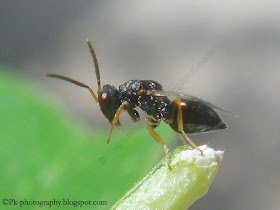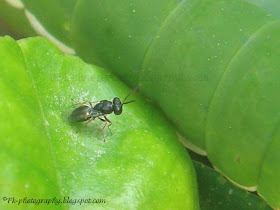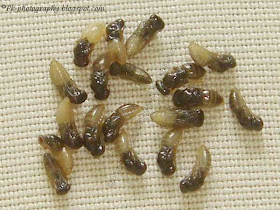This year most of the pupae (about 90%), I found in nature were parasitized by
Pteromalus Puparum.
Pteromalus puparum is a small (about 3mm long) parasitic wasp in the order Hymenoptera, superfamily Chalcidoidea, family Pteromalidae, that develops inside butterfly pupae. The wasp deposit eggs inside the skin of the pre-pupa caterpillar or puparial wall of the newly formed pupa. The eggs hatch into larvae, which consume the inside organs of pupa and on maturity turn into pupae. The mature wasps emerges from host pupa through a tiny hole.
Pteromalus puparum is consederd biological control of caterpillar pests particularly cabbage white butterfly and that is why it's known as "Cabbage White Butterfly Pupal Parasite". According to my personal observations the pupae parasitized by
Pteromalus puparum wasp, were include pupae of plain tiger, cabbage white, bath white, citrus swallowtail and ladybug.
Parasitic Wasp-Pteromalus Puparum
 |
| Parasitic Wasp-Pteromalus Puparum |
 |
| Parasitic Wasp-Pteromalus Puparum |
 |
| Parasitic Wasp-Pteromalus Puparum on Caterpillar |
 |
| Parasitic Wasp-Pteromalus Puparum |
 |
| Pteromalus Puparum Larvae |
 |
| Pteromalus Puparum Larvae |
 |
| Pteromalus Puparum Pupae |
 |
| Pteromalus Puparum Pupae |








Wow, what a detailed observation!
ReplyDeleteAn excellent series Birdy. There are mant wasps which do this. I wonder why they are too lazy to bring up their offspring?
ReplyDeleteOh wow that is one interesting insect, and that small. Thanks for sharing, you always have great stuff here to learn, and never mind the photos, they are nice and crisp. Well done. Anna :)
ReplyDeleteFantastic close up shots Birdy :))and a very interesting post !!
ReplyDeletea detailed photo-log :)
ReplyDeletenice one... I am also trying to get some good insects but my cam can not capture the details like urs ...
nice shot :)
thanks and happy belated Eid!
Awesome pictures :)
ReplyDeleteThis is an excellent post. As an ecologist I was fascinated by actually seeing the parasitic wasp and larvae in action. What a great survival tool for this wasp, but not so good for caterpillar larvae!
ReplyDeleteThanks!
extraordinary photos
ReplyDeleteAmazing photos nice shots man...really it needs a great sense of photography.Honestly i have not photos this much clear.
ReplyDeleteNice close ups, not good for the faint hearted though eh?
ReplyDeleteThanks you all for the visit and feedback. I always love to here from you.
ReplyDeleteA very interesting article coupled with fantastic pictures, thanks a lot for the information!
ReplyDelete